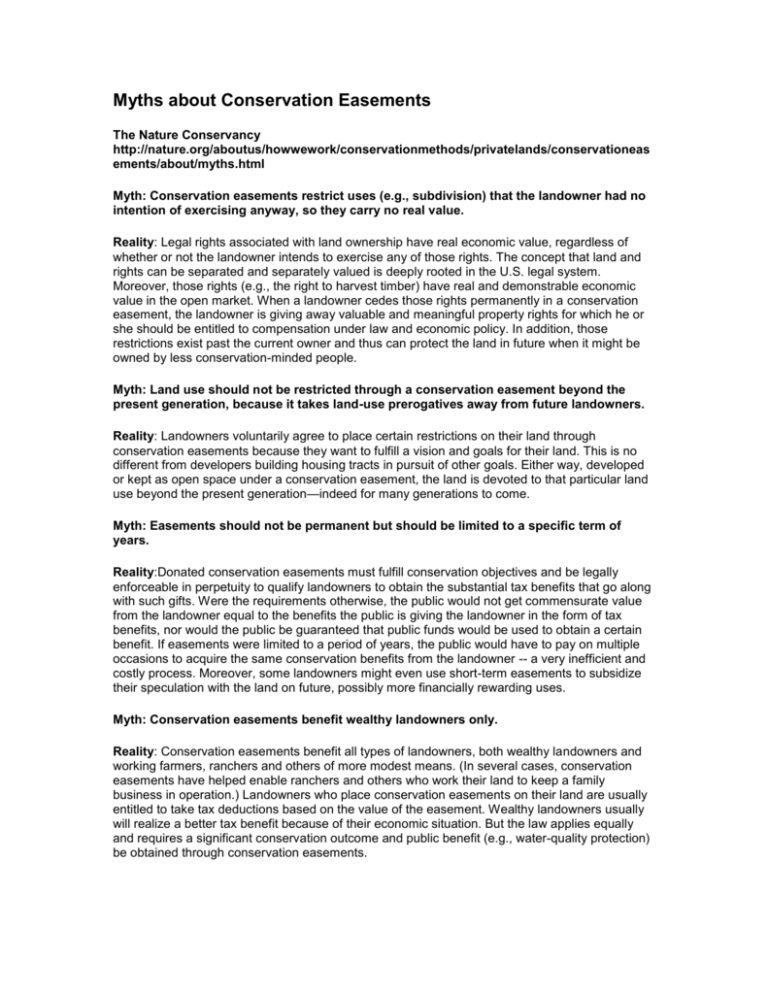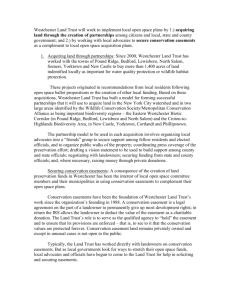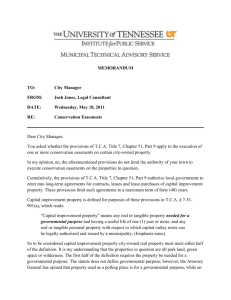Myths about Conservation Easements
advertisement

Myths about Conservation Easements The Nature Conservancy http://nature.org/aboutus/howwework/conservationmethods/privatelands/conservationeas ements/about/myths.html Myth: Conservation easements restrict uses (e.g., subdivision) that the landowner had no intention of exercising anyway, so they carry no real value. Reality: Legal rights associated with land ownership have real economic value, regardless of whether or not the landowner intends to exercise any of those rights. The concept that land and rights can be separated and separately valued is deeply rooted in the U.S. legal system. Moreover, those rights (e.g., the right to harvest timber) have real and demonstrable economic value in the open market. When a landowner cedes those rights permanently in a conservation easement, the landowner is giving away valuable and meaningful property rights for which he or she should be entitled to compensation under law and economic policy. In addition, those restrictions exist past the current owner and thus can protect the land in future when it might be owned by less conservation-minded people. Myth: Land use should not be restricted through a conservation easement beyond the present generation, because it takes land-use prerogatives away from future landowners. Reality: Landowners voluntarily agree to place certain restrictions on their land through conservation easements because they want to fulfill a vision and goals for their land. This is no different from developers building housing tracts in pursuit of other goals. Either way, developed or kept as open space under a conservation easement, the land is devoted to that particular land use beyond the present generation—indeed for many generations to come. Myth: Easements should not be permanent but should be limited to a specific term of years. Reality:Donated conservation easements must fulfill conservation objectives and be legally enforceable in perpetuity to qualify landowners to obtain the substantial tax benefits that go along with such gifts. Were the requirements otherwise, the public would not get commensurate value from the landowner equal to the benefits the public is giving the landowner in the form of tax benefits, nor would the public be guaranteed that public funds would be used to obtain a certain benefit. If easements were limited to a period of years, the public would have to pay on multiple occasions to acquire the same conservation benefits from the landowner -- a very inefficient and costly process. Moreover, some landowners might even use short-term easements to subsidize their speculation with the land on future, possibly more financially rewarding uses. Myth: Conservation easements benefit wealthy landowners only. Reality: Conservation easements benefit all types of landowners, both wealthy landowners and working farmers, ranchers and others of more modest means. (In several cases, conservation easements have helped enable ranchers and others who work their land to keep a family business in operation.) Landowners who place conservation easements on their land are usually entitled to take tax deductions based on the value of the easement. Wealthy landowners usually will realize a better tax benefit because of their economic situation. But the law applies equally and requires a significant conservation outcome and public benefit (e.g., water-quality protection) be obtained through conservation easements. Myth: Because conservation easements lower a land's value, they give conservation organizations an advantage in purchasing the land in the future. Reality: It is in the Conservancy's best interest to keep lands both in private ownership and managed for conservation benefit. Easements are an efficient way to achieve these goals. The Conservancy does not have enough funds to buy all the lands that need to be managed for conservation purposes. The organization would not spend limited funds to purchase lands already protected by conservation easements. Myth: Because landowners are entitled to a federal tax benefit, the public should be given access to the property protected by conservation easements. Reality: Conservation easements do not necessarily mean properties are opened up to public access unless so specified in an easement or as required by law. Landowners who place conservation easements on their land are providing substantial benefits to the public even if the land is not open for physical public access. The public receives the benefit of keeping land in open space for scenic vistas and in working land uses, such as farming and ranching. Myth: It is inappropriate to use tax policy to encourage land conservation. The tax system should be used only to raise revenue. Landowners instead should be paid directly for the benefits they provide in the form of conservation easements. Reality: True, the function of the tax system is to raise revenue; but current tax rules reflect many of the values and community standards of our society. These rules encourage individuals to donate to churches, schools and other charitable institutions and provide economic incentives to encourage many different kinds of business activities, for example. Since the conservation of private land is an important goal for our society in general, and since we already use the tax code to encourage such worthwhile activity, it is entirely appropriate to give private landowners tax benefits for legitimate actions they take to further those objectives. Indeed, it may even be more cost effective and efficient for the public to provide tax benefits for conservation easements (otherwise known as a "tax expenditure") rather than appropriate and spend public dollars directly to acquire such rights. Myth: A land trust might sell or use the development rights it obtains through a conservation easement. Reality: A land trust or government agency does not actually hold the rights given up by a landowner through a conservation easement, but rather holds the right to enforce the landowner's promise not to exercise those rights in the future. Under an easement, development and other affirmative rights in the land are extinguished and, in theory and practice, no longer exist—and therefore cannot be exercised by anyone in the future. Myth: Local communities suffer because conservation easements lower property taxes, in turn diminishing local revenue. Reality: It is true that lands subject to conservation easements are often subject to lower property tax assessment because the land's highest and best use has been diminished permanently. Thus, in theory, lands subject to conservation easements should pay lower property taxes. However, this myth looks only at the revenue side of the budget of local communities, not at the expense side of the budget equation. As shown in several "cost of community services studies" conducted nationwide, undeveloped and open lands (often those that are protected by conservation easements) demand less in community or public services than do developed lands or other types of land uses. On balance, open lands often provide greater community benefit than do other types of land uses. This is especially true where open or working lands are subject to easements and remain in private ownership, as these lands will continue to generate some level of property tax and contribute more in local revenues than they require in services.







